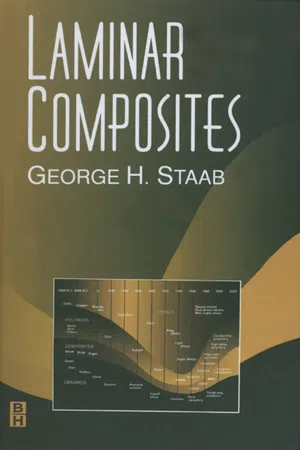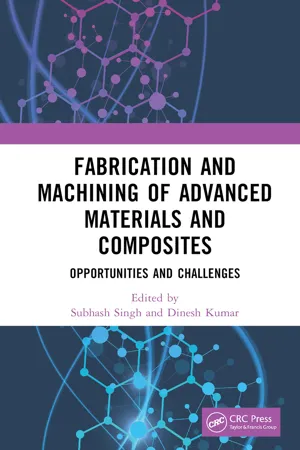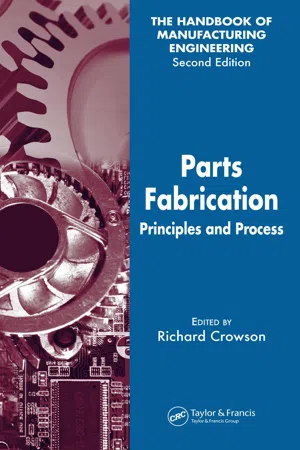Technology & Engineering
Composite Body
A composite body refers to a material made from two or more different substances with distinct properties, combined to create a new material with enhanced characteristics. These substances can include polymers, ceramics, or metals, and the resulting composite body often exhibits improved strength, durability, and other desirable properties compared to its individual components.
Written by Perlego with AI-assistance
Related key terms
1 of 5
8 Key excerpts on "Composite Body"
- eBook - ePub
- Julian Happian-Smith(Author)
- 2001(Publication Date)
- Butterworth-Heinemann(Publisher)
The properties of ceramics are dominated by these materials forming hard and brittle components. They fail in a brittle manner or by thermal shock, in contrast to most engineering metals, which generally fail by plastic deformation, fatigue or corrosion. Thus, whilst the tensile modulus and strength are of concern, of greater importance in the design of ceramic vehicle components, are the bend strength or ‘modulus of rupture’ and ‘thermal shock resistance’. As with metals, ceramics show general property bands of behaviour. For specific ceramic materials, test data are needed for design purposes and final quality assurance tests are essential on the finished products. However, property variations within a production batch are much greater than for metal components. The structure-insensitive properties, such as theoretical density, elastic modulus and melting point may vary by about 10%. In contrast, structuresensitive properties, such as fracture toughness, modulus of rupture and some thermal properties are much more variable within a product batch, requiring detailed statistical analysis. Consequently, whilst there appeared to be exciting engineering possibilities for technical ceramics, in the 1980s, their potential has not yet been realized in vehicle design.2.2.4 Composite materials
A composite material is a combination of two materials, with its own distinctive properties. Its strength or other desirable quality is better or very different from either of its components working alone. The principal attraction of composite materials is that they are lighter, stiffer and stronger than most other structural materials. They were developed to meet the severe demands of supersonic flight, space exploration and deep water applications, but are now used in general engineering including automotive applications. Composite materials imitate nature. Wood is a composite of cellulose and lignin; cellulose fibres are strong in tension but flexible and lignin acts to cement the fibres together to create a material with stiffness. Man-made composites achieve similar results by combining strong fibres such as carbon or glass, in a softer matrix such as epoxy or polyester resin.In the broadest sense, most engineering materials are composites; for example, steels are painted to prevent rusting of valuable structural components. The more usual concept is illustrated by the bi-metallic strip used in water thermostats. Firstly, neither the iron nor the brass alone would be useful in this application. The combination of the two has an entirely new property. Secondly, the two components act together to equalize their different strains. This property of combined action is most important in the design of composite materials and components.The ideal load-bearing component or structure is made of a material that is light in weight, strong in tension and not easily corroded. It must expand very little with changes in temperature, with a high resistance to abrasion and a high softening or melting point. In vehicle engineering, high strength and stiffness per unit weight or density are all important ‘design properties’. Materials with these properties are ceramics such as glass, boron carbide, alumina, silicon carbide, as well as carbon. They also have high softening or melting points and low coefficients of expansion. In addition, they can be made from inexpensive raw materials such as sand, coke and coal. Metals are usually poor on a unit weight basis apart from magnesium and titanium. Polymers are satisfactory on a strength-to-weight basis but are poor in terms of stiffness-to- weight ratio. - Hota V.S. GangaRao, Narendra Taly, P. V. Vijay(Authors)
- 2006(Publication Date)
- CRC Press(Publisher)
19 2 Properties of Constituent Materials: Concrete, Steel, Polymers, and Fibers 2.1 INTRODUCTION Development of composite materials represents a milestone in the history of our civilization. Along with conventional building materials such as steel, concrete, alu-minum, and wood, composite materials offer an excellent alternative for a multitude of uses. Use of composite materials was pioneered by the aerospace industry beginning in the 1940s, primarily because of the material’s high-performance and lightweight qualities. Today their potential is being harnessed for many uses. Advanced composite materials — so called because of their many desirable properties, such as high-performance, high strength-to-weight and high stiffness-to-weight ratios, high energy absorption, and outstanding corrosion and fatigue damage resistance — are now increasingly used for civil engineering infrastructure such as buildings and bridges. Composite materials are manufactured from two or more distinctly dissimilar materials — physically or chemically — that are suitably arranged to create a new material whose characteristics are completely different from those of its constituents. Basically, composites consist of two main elements: the structural constituent, which functions as the load carrying element, and the body constituent called matrix , which encloses the composite. The structural constituent can be in the form of fibers, particles, laminae (or layers), flakes, and fillers. The matrix performs important dual functions: It acts as a binder to hold the fibrous phase in place (i.e., holds the fibers in a structural unit) protecting fibers from environmental attack, and under an applied load, it deforms and distributes the load to the high modulus fibers. Composites discussed in this book are those fabricated from fibers such as glass, carbon, aramid, and boron.- eBook - ePub
- George Staab(Author)
- 1999(Publication Date)
- Butterworth-Heinemann(Publisher)
1INTRODUCTION TO COMPOSITE MATERIALS
1.1 Historic and Introductory Comments
In the most general of terms, a composite is a material that consists of two or more constituent materials or phases. Traditional engineering materials (steel, aluminum, etc.) contain impurities that can represent different phases of the same material and fit the broad definition of a composite, but are not considered composites because the elastic modulus or strength of the impurity phase is nearly identical to that of the pure material. The definition of a composite material is flexible and can be augmented to fit specific requirements. In this text a composite material is considered to be one that contains two or more distinct constituents with significantly different macroscopic behavior and a distinct interface between each constituent (on the microscopic level). This includes the continuous fiber laminated composites of primary concern herein, as well as a variety of composites not specifically addressed.Composite materials have been in existence for many centuries. No record exists as to when people first started using composites. Some of the earliest records of their use date back to the Egyptians, who are credited with the introduction of plywood, papier-mâché, and the use of straw in mud for strengthening bricks. Similarly, the ancient Inca and Mayan civilizations used plant fibers to strengthen bricks and pottery. Swords and armor were plated to add strength in medieval times. An example is the Samurai sword, which was produced by repeated folding and reshaping to form a multilayered composite (it is estimated that several million layers could have been used). Eskimos use moss to strengthen ice in forming igloos. Similarly, it is not uncommon to find horse hair in plaster for enhanced strength. The automotive industry introduced large-scale use of composites with the Chevrolet Corvette. All of these are examples of man-made composite materials. Bamboo, bone, and celery are examples of cellular composites that exist in nature. Muscle tissue is a multidirectional fibrous laminate. There are numerous other examples of both natural and man-made composite materials. - eBook - ePub
Fabrication and Machining of Advanced Materials and Composites
Opportunities and Challenges
- Subhash Singh, Dinesh Kumar, Subhash Singh, Dinesh Kumar(Authors)
- 2022(Publication Date)
- CRC Press(Publisher)
Chapter 1 Introduction, History, and Origin of Composite Materials Subhash Singh Department of Mechanical and Automation Engineering, Indira Gandhi Delhi Technical University for Women, New Delhi, India Mohammad Uddin Department of Mechanical Engineering, South University of Australia Chander Prakash School of Mechanical Engineering, Lovely Professional University, Phagwara, IndiaDOI: 10.1201/9781003327370-1CONTENTS- 1.1 Introduction to Composites
- 1.2 Applications of Composites
- 1.2.1 Aircrafts and Aerospace
- 1.2.2 Automotive and Transportation
- 1.2.3 Marine
- 1.2.4 Construction and Infrastructure
- 1.2.5 Corrosive Environments
- 1.2.6 Energy
- 1.2.7 Electricals and Electronics
- 1.2.8 Sports/Recreational Applications
- 1.3 Historical Evolution of the Composites
- 1.4 Conclusions
- References
1.1 Introduction to CompositesComposites are material systems with multiple phases produced by combining diverse materials in an attempt to achieve those superior characteristics as well as performance which cannot be achieved by the individual constituting components [1 ]. Unlike in alloys, the obtained phases within a composite aren’t due to phase transformations, natural reactions, or any alternative phenomena. An alloy is always a homogeneous mixture in which the components added don’t retain their original characteristics and are generated by natural processes. This isn’t the case within a composite because the added constituents restore their original characteristics and also the composite needn’t always be homogenous [2 ]. That's the basic difference between an alloy and a composite. When observed at a macroscopic scale, among the various phases, a composite would generally comprise of a continuous, weaker phase, termed “the matrix” and a much stronger, stiffer phase termed “reinforcement.” But in certain situations, due to the effects of processing and chemical reactions, between the phases there would be another distinct phase termed “interphase” present among the matrix as well as the reinforcements [3 ]. Finally, a composite is formed with stacked layers of reinforcement fibers as well as a matrix with required characteristics in a particular direction or in multi-directions. Fig. 1.1 - No longer available |Learn more
- Louis C. Dorworth, Ginger L. Gardiner, Dr. Greg M. Mellema(Authors)
- 2019(Publication Date)
- Aviation Supplies & Academics, Inc.(Publisher)
Chapter 1: Composite Technology Overview Composites vs. Advanced CompositesComposites are comprised of two or more materials working together, where each constituent material retains its unique identity within the composite and contributes its own structural properties, yet upon combination the resulting material has superior properties to those of its constituents. A good example of an everyday composite material is concrete. Concrete is made with select amounts of sand, aggregate, and perhaps even glass fiber mixed with cement to bind it together. If the concrete were broken open, the individual constituents would be visible. The type and quantities of these individual constituents can also be adjusted to give the resulting concrete different properties depending on the application.This textbook is focused on composite laminates, which combine fibers and a matrix material that binds the fibers together. There are many different types of composite materials in use today. One example is fiber-reinforced plastic (FRP) composites made with short glass fibers in a polymer resin or plastic matrix. These materials are used in bath tubs, showers, pools, doors, car fenders, and a variety of construction materials including wall panels, corrugated sheet, profiles, and skylights. (Figure 1-1)Figure 1-1. Fiber-reinforced compositeHighly loaded composite structures typically use continuous or long-fiber reinforcement that transfers load along bundles or layers (plies - eBook - PDF
Engineering Fundamentals
An Introduction to Engineering, SI Edition
- Saeed Moaveni(Author)
- 2019(Publication Date)
- Cengage Learning EMEA(Publisher)
Cengage Learning reserves the right to remove additional content at any time if subsequent rights restrictions require it. 17.5 Wood, Plastics, Silicon, Glass, and Composites 713 Composites Because of their light weight and good strength, composite materials are increas- ingly the materials of choice for a number of products and aerospace applications. Today, you will find composite materials in military planes, helicopters, satellites, commercial planes, fast-food restaurant tables and chairs, and many sporting goods. They also commonly are used to repair bodies of automobiles. In comparison to conventional materials (such as met- als), composite materials can be lighter and stronger. For this reason, composite materials are used extensively in aerospace applications. Composites are created by combining two or more solid mate- rials to make a new material that has properties that are superior to those of the individual components. Composite materials con- sist of two main ingredients: matrix material and fibers. Fibers are embedded in matrix materials, such as aluminum or other metals, plastics, or ceramics. Glass, graphite, and silicon carbide fibers are examples of fibers used in the construction of composite materials. The strength of the fibers is increased when embedded in the matrix material, and the com- posite material created in this manner is lighter and stronger. Moreover, once a crack starts in a single material due to either excessive loading or imperfections in the material, the crack will propagate to the point of failure. In a composite material, on the other hand, if one or a few fibers fail, it does not necessarily lead to failure of other fibers or the material as a whole. Furthermore, the fibers in a composite material can be oriented either in a certain direction or many directions to offer more strength in the direction of expected loads. Therefore, composite materials are designed for specific load applications. - F L Matthews, G A O Davies, D Hitchings, C Soutis(Authors)
- 2000(Publication Date)
- Woodhead Publishing(Publisher)
Also some features of composite construction, such as filament winding, cannot easily be represented (if at all) by some FE packages. Following a review of com-posites and the FE method, the application of the method to composites is discussed in detail. The particular issues are then illustrated via a number of examples taken from particular situations. Overview 5 2 Fundamentals of composites 2.1 Basic characteristics 2.1.1 Definitions and classification A composite is a mixture of two or more distinct constituents or phases. In addition three other criteria are normally satisfied before we call a ma-terial a composite. Firstly, both constituents have to be present in reason-able proportions. Secondly, the constituent phases should have distinctly different properties, such that the composite’s properties are noticeably different from the properties of the constituents. Lastly, a synthetic composite is usually produced by deliberately mixing and combining the constituents by various means. We know that composites have two (or more) chemically distinct phases on a microscopic scale, separated by a distinct interface, and it is important to be able to specify these constituents. The constituent that is continuous and is often, but not always, present in the greater quantity in the compo-site is termed the matrix. The normal view is that it is the properties of the matrix that are improved upon when incorporating another constituent to produce a composite. A composite may have a ceramic, metallic or poly-meric matrix. The mechanical properties of these three classes of material differ considerably. As a generalisation, polymers have low strengths and Young’s moduli, ceramics are strong, stiff and brittle, and metals have inter-mediate strengths and moduli, together with good ductilities, i.e. they are not brittle. Because of their economic importance, the emphasis in this text will be on polymer matrix composites (PMCs).- eBook - PDF
Parts Fabrication
Principles and Process
- Richard Crowson(Author)
- 2006(Publication Date)
- CRC Press(Publisher)
229 Composite Manufacturing John F. Maguire with Don Weed and Thomas J. Rose 6.0 INTRODUCTION AND BACKGROUND It is difficult to find a truly satisfactory definition of composite material. The American Heritage Dictionary (Houghton Mifflin, Boston, 1981) comes close, with “a complex material, such as wood or fiber glass, in which two or more complementary substances, especially metals, ceramics, glasses, and polymers, combine to produce some structural or functional properties not present in any individual component.” The problem with even a good definition, of course, is that it is all-encompassing, so that every material in the universe could in some sense be defined as a composite. This loss of exclusivity diminishes the usefulness of the definition. For our purposes, we shall restrict attention to that subset of materials known as fiber-reinforced advanced polymeric composites. In these materials, a reinforcing fiber is embedded in an organic polymeric resin. The fiber acts as a structural reinforcement and the resin binds the fibers together. This transfers loads and provides structural and dimensional integrity. Advanced composite materials, developed in the latter half of the twentieth cen-tury, may well provide a key to enabling technology for the twenty-first century. These materials are strong, light, and corrosion resistant, offering considerable tech-nical advantages in aerospace, automotive, offshore petrochemical, infrastructure, and other general engineering applications. Composite components may be made by laminating or laying up layers of composite material, each ply consisting of one or more patterns, which may be as large as 4 1/2 ft wide by 9 ft long. These patterns are cut from a continuous roll of cloth, or from sheets, with standard widths measuring up to 4 1/2 ft. Composite material wider than 12 in. is referred to as broadgoods. If a material is narrower, it is usually a unidirectional tape. In such a tape the fibers run 6
Index pages curate the most relevant extracts from our library of academic textbooks. They’ve been created using an in-house natural language model (NLM), each adding context and meaning to key research topics.







